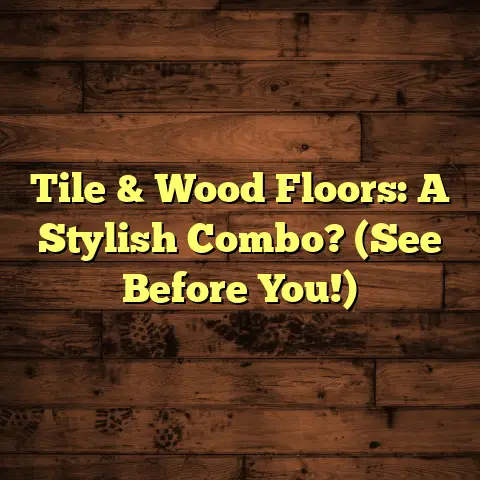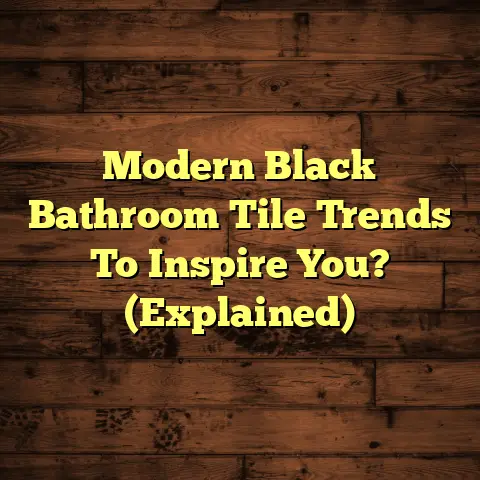How To Paint Plywood Floors? (Explained)
“Creativity is allowing yourself to make mistakes.
Art is knowing which ones to keep.” – Scott Adams
Painting plywood floors can be a transformative project that brings new life to a space while also being budget-friendly.
I remember my first experience with this kind of project; it was a small room in my house that had seen better days.
The old, scratched plywood was an eyesore, and I thought, “Why not paint it?” Spoiler alert: it turned out to be one of the best decisions I ever made!
Getting Started: What You Need
Before jumping into the painting process, it’s crucial to gather the right materials.
Here’s a list of what I typically use:
- Plywood Flooring: Make sure your plywood is clean and dry.
- Primer: A high-quality primer suitable for wood surfaces.
- Paint: I usually opt for acrylic or latex paint for durability.
- Sealer: To protect the paint and add a shine.
- Paintbrushes & Rollers: A variety of sizes for detailed work and broad areas.
- Sandpaper: For smoothing the surface.
- Drop Cloths: To protect areas you don’t want to paint.
- Masking Tape: For clean edges.
Personal Anecdote
I once tried painting over a rough plywood surface without sanding it first.
Let me tell you, that was a mistake!
The paint didn’t adhere well, and I ended up with a patchy finish that looked amateurish at best.
So trust me on this one: preparation is key.
Step 1: Preparing the Surface
Proper preparation can make or break your project. Here’s how I do it:
- Clean the Floor: Start by sweeping and mopping the floor to remove any dust and debris.
You want a clean slate. - Sanding: Using medium-grit sandpaper, I sand the surface to make it smooth.
This step is vital for ensuring the paint adheres properly. - Priming: After cleaning and sanding, apply a coat of primer.
This not only helps the paint stick but also provides a uniform base.
I’ve found that using a roller for large areas and a brush for edges works best. - Drying Time: Allow the primer to dry completely, which usually takes about 1-2 hours, depending on humidity and temperature.
Step 2: Choosing Your Paint
When it comes to paint, I’ve experimented with various brands and types over the years.
Acrylic paint holds up well in high-traffic areas due to its durability and ease of cleaning.
Cost Considerations
Using FloorTally really helps me when estimating costs for materials.
For instance, I can input local prices for primer and paint based on current market rates, ensuring my budget stays on track.
It’s also handy for calculating labor costs if I’m bringing in additional help for larger jobs.
Step 3: Painting the Floor
Now comes the fun part—painting! Here’s how I approach this step:
- Applying the First Coat: I start with a roller for large areas and use a brush for corners and edges.
It’s usually best to work from one side of the room to the other to avoid stepping on wet paint. - Drying Time: Allow the first coat to dry as per the manufacturer’s instructions, usually around 4-6 hours.
- Second Coat: Once the first coat is dry, apply a second coat in the same manner.
This ensures even coverage and better durability.
Challenges Faced
One time, I painted during a particularly humid day, and I noticed the paint took longer to dry than expected.
While it didn’t ruin my project, it did prolong my timeline.
Lesson learned: always check the weather before starting!
Step 4: Sealing the Paint
After the final coat of paint dries, I recommend sealing it for added protection:
- Choosing a Sealer: A water-based polyurethane works well for sealing painted plywood floors.
It adds a layer of durability without altering the color. - Application: Use a clean roller to apply the sealer evenly across the surface.
- Curing Time: Let the sealer cure according to the manufacturer’s recommendations—usually about 24 hours.
Maintenance Tips
Maintaining painted plywood floors is straightforward:
- Regular Cleaning: Sweep or vacuum regularly and mop with mild soap and water.
- Avoid Harsh Chemicals: They can damage the finish.
- Reapply Sealer Annually: To keep your floors looking fresh, consider resealing them once a year.
Creative Design Ideas
Now that you know how to paint plywood floors, let’s dive into some creative design ideas that can take your project to the next level.
Striped Patterns
One of my favorite techniques is creating striped patterns on the floor.
Here’s how I do it:
- Choose Your Colors: Pick two or three complementary colors that will work well together.
- Measuring and Marking: Use a measuring tape and chalk line to mark where you want your stripes.
- Tape Off Areas: Apply masking tape along your chalk lines to create crisp edges.
- Paint Alternate Stripes: Start painting every other stripe and allow it to dry before removing the tape.
This method adds depth and character to any room.
Stenciling
Stenciling is another fun way to personalize your plywood floor:
- Select a Pattern: Look for designs that match your décor style—geometric patterns are trendy right now.
- Secure Your Stencil: Use spray adhesive or tape to keep your stencil in place.
- Dab Paint Over the Stencil: Using a stencil brush, dab paint over your stencil until you achieve your desired opacity.
- Remove Carefully: Slowly peel away the stencil while the paint is still slightly wet for clean edges.
I’ve used stencils in children’s playrooms and entryways; they always receive compliments!
Troubleshooting Common Issues
Even with careful planning, sometimes things don’t go as expected.
Here are common issues I’ve faced and how I resolved them:
Paint Peeling
If you notice peeling paint after some time, it may be due to poor adhesion from improper preparation or moisture issues:
- Solution: Sand down the affected area, clean it thoroughly, and reapply primer before repainting.
Color Fading
If your painted floor starts fading over time, it could be due to direct sunlight exposure:
- Solution: Consider adding curtains or UV-filtering window film to reduce sun exposure on high traffic areas.
Scratches and Scuffs
High traffic areas can become scuffed or scratched over time:
- Solution: Touch up these areas with leftover paint as needed or consider applying an additional sealer layer.
Cost Breakdown
When budgeting for painting plywood floors, here’s how my costs typically break down:
- Plywood Sheets: Depending on thickness and type, around $20-$40 per sheet.
- Primer: Approximately $15-$30 per gallon.
- Paint: Quality acrylic or latex paint can range from $30-$60 per gallon.
- Sealer: Water-based polyurethanes cost about $20-$50 per gallon.
- Miscellaneous Supplies (brushes, rollers, tape): Budget around $25-$50 total.
Using FloorTally makes estimating these costs straightforward, allowing me to input local prices quickly and adjust based on current market conditions.
Comparisons with Other Flooring Options
While painting plywood floors can be an excellent choice, it’s worth comparing it with other flooring options that might tempt you:
Laminate Flooring
Laminate offers durability and scratch resistance but often comes at a higher cost than painted plywood floors.
Installation can be more complex as well, especially with click-lock systems requiring precise measurements.
Vinyl Plank Flooring
Vinyl planks are waterproof and come in various styles that mimic wood grain but may lack the character that painted plywood can provide through custom designs.
Hardwood Flooring
Hardwood provides timeless beauty but comes with a significantly higher price tag and requires professional installation in many cases.
Maintenance can also be costly over time.
In my experience, painted plywood serves as an affordable alternative while allowing for creative expression—something I prioritize in my projects!
Environmental Considerations
If you’re conscious about sustainability like I am, here are some eco-friendly tips when painting plywood floors:
- Choose Low-VOC Paints: Many brands now offer low-VOC options that are better for indoor air quality.
- Use Recycled Materials: If you’re replacing old flooring, consider reusing or repurposing materials whenever possible.
- Dispose Responsibly: Properly dispose of any leftover paints or chemicals at designated disposal sites instead of pouring them down the drain.
Conclusion
Painting plywood floors can be an incredibly rewarding project that offers both aesthetic appeal and practicality.
Through my experiences, I’ve found that proper preparation, quality materials, and attention to detail make all the difference.
Whether you’re looking for an affordable flooring option or want to express your creativity through design, painting plywood floors can provide just what you need.
Have you ever painted your floors?
What was your experience like?
Let’s share tips and tricks!





